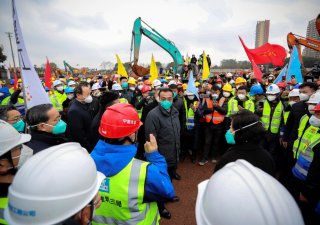China Touts Infrastructure Spending As Fears of Economic Decline Grow
Beijing is banking on massive infrastructure projects to bolster its economy.
With the Omicron variant clouding predictions of economic recovery around the world, China has pushed for a series of massive infrastructure investment projects.
Beijing has stated that these projects, which it hopes to undertake immediately, will stabilize the country’s economy after several high-profile incidents within the construction and real estate sectors shook investor confidence and raised fears of a downturn.
“Our economic operations are now at the key stage of surmounting obstacles,” a statement published by the government read on Monday. “We must put growth stabilization in a more prominent position, and firmly implement the strategy of domestic demand expansion,” the statement continued.
While Chinese leaders acknowledged that the high transmissibility of the Omicron variant would complicate the country’s economic recovery from COVID-19, they emphasized that increased investment and consumption could help to reinvigorate the economy.
As part of this strategy, the Chinese cabinet has proposed to undertake 102 major public infrastructure projects between 2021 and 2025. China highlighted several key areas for increased investment, including advanced manufacturing, energy security, food production, infrastructure development, and affordable housing.
Beijing’s latest push for economic recovery also comes as three major cities—Anyang, Xi’an, and Yuzhou—are in the midst of extremely harsh lockdown measures to prevent the spread of the virus. In Xi’an, for example, local authorities banned driving within the city and ordered all residents to remain in their houses, only allowing one household member to leave every three days to purchase supplies.
These measures have been highly effective at containing the spread of COVID-19, giving China one of the lowest infection rates in the world according to local sources. However, they have also harmed the country’s economy. An ANZ bank analysis suggested that the country’s GDP growth in the fourth quarter of 2021 could have decreased to 3.6 percent, down from 4.9 percent in the third quarter. The same analysis put 2022’s projected GDP growth at 4.6 percent—roughly half of the previously predicted 8 percent increase.
Relying on public infrastructure spending to prop up the economy during downturns is a common technique with roots in Keynesian economic policy. However, within China, these efforts have sometimes led to increases in local government debts with little tangible economic benefit.
Trevor Filseth is a current and foreign affairs writer for the National Interest.
Image: Reuters.

